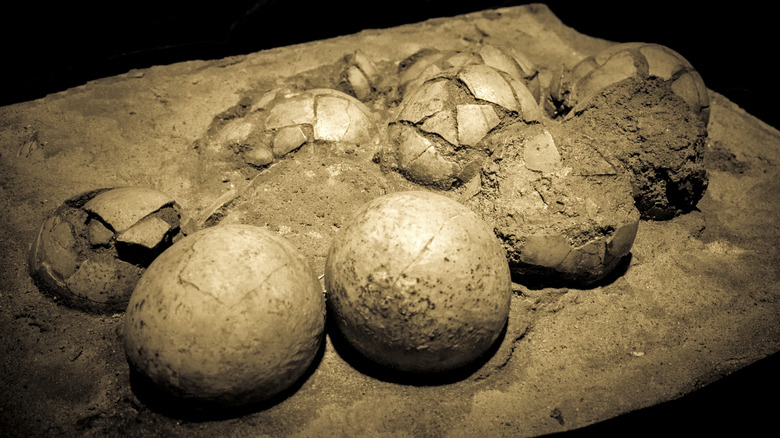Were Dinosaurs Cold-Blooded Or Hot-Blooded?
Dinosaurs are endlessly fascinating, in large part because there is still much we don't know about them. Although we have been studying dinosaur fossils for over 100 years, scientists are still learning much about the magnificent creatures. However, a recent study may have just revealed previously unknown information about their internal body temperature regulation.
Warm-blooded animals, like humans and other mammals, maintain a constant internal temperature, regardless of their surroundings, using internal and external mechanisms to regulate their metabolic rates and maintain body temperature, per Microbe Notes. Cold-blooded creatures like reptiles, amphibians, and fish, on the other hand, have a body temperature that fluctuates in relation to the environment. While you might think dinosaurs would be more likely to be cold-blooded like reptiles, thanks to modern illustrations that depict most dinosaurs are large, scaly, reptilian creatures, new evidence seems to show that they may have actually been warm-blooded.
According to a study conducted at the University of Massachusetts-Amherst in February 2020, the eggshell fossils of three major dinosaur groups indicate that they likely had warm internal body temperature. "Dinosaurs sit at an evolutionary point between birds, which are warm-blooded, and reptiles, which are cold-blooded. Our results suggest that all major groups of dinosaurs had warmer body temperatures than their environment," Robin Dawson, the study's lead author, explained in a statement, via Yale.
Eggshell fossils may hold the answer
The study, published in "Science Advances," used a testing process called "clumped isotope paleothermometry" to analyze the ordering of oxygen and carbon atoms in the dinosaurs' fossil eggshells, according to Earth Sky. Researchers looked at eggshell fossils from a small, meat-eating theropod called a Troodons, from the Maiasaura, a large, duck-billed dinosaur, and from a species of dinosaur eggs known as Megaloolithus. They then compared the findings with the shells of current cold-blooded invertebrate shells from the same locations, to determine the temperature of the environment. The results showed that all three samples of eggshells had temperatures higher than the local environment, indicating that they were likely warm-blooded.
Although dinosaurs might look similar to reptiles, birds are actually their closest living relatives, and they are warm-blooded as well. Birds maintain a stable internal body temperature of around 106 degrees Fahrenheit, regardless of external conditions. "Big birds, like geese and grouse, do what we do. They put on insulation" when the weather gets cold, University of South Dakota physiologist David Swanson explained, via the Audubon Society. This insulation includes both fat and downy feathers, which they use to protect themselves from the elements. It appears that their ancient ancestors, the dinosaurs, developed this evolutionary skill as well. "It's possible that dense feathers were primarily selected for insulation, as body size decreased in theropod dinosaurs on the evolutionary pathway to modern birds," Dawson explained (via Earth Sky).

